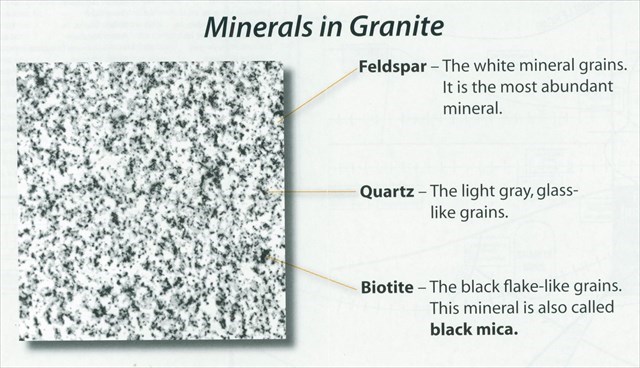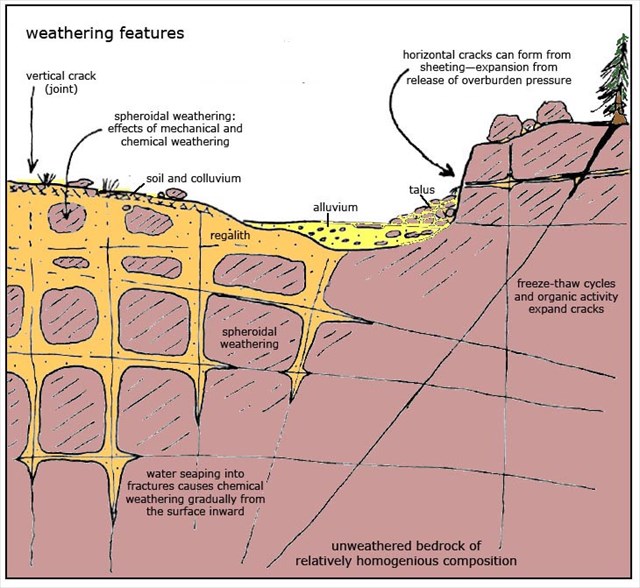This cache will bring you to the most identifiable peak in the eastern reaches of Cardinia Shire – Mt Cannibal.
We wanted to highlight a unique aspect clearly visible in the Granite here.
Granite it is the most common igneous rock found at Earth's surface. It is one of the most commonly recognised igneous rocks because it is used to make so many objects that we encounter in daily life. These include counter tops, floor tiles, paving stone, curbing, stair treads, building veneer, monuments and cooking utensils. Many natural landmarks are also made of granite.
Granite is a light-colored igneous rock with grains large enough to be visible with the unaided eye. It forms from the slow crystallization of magma below Earth’s surface. Granite is composed mainly of quartz and feldspar with minor amounts of mica, amphiboles and other minerals. This mineral composition usually gives granite a red, pink, grey or white colour with dark mineral grains visible throughout the rock.

Granite is nearly always massive and very hard. The average density of granite is between 2.65 and 2.75 g/cm, its compressive strength usually lies above 200 MPa, and its viscosity near STP is 3–6 • 10 Pa·s.
The melting temperature of dry granite at ambient pressure is 1215–1260 °C it is strongly reduced in the presence of water, down to 650 °C at a few kBar pressure.
Granite has poor primary permeability, but strong secondary permeability.
Weathering is the natural process of breaking down materials. Weathering processes fall in two categories: mechanical weathering and chemical weathering. Weathering processes are essential components of erosion and deposition of sediments.
- Mechanical weathering includes all processes that simply "break big pieces into little pieces."
- Chemical weathering are processes that gradually dissolve or disassemble rocks through electrochemical activity.
In nature, the two types of weathering processes may occur simultaneously, but not always at the same rates.
- Erosion is simply moving material in some fluid (such as air, water, ice).
- Deposition involves processes that stop the surface transport of materials. This is followed by burial or further erosion.

Mechanical weathering is typically associated with processes at or near the surface, and may take place with processes associated with erosion. However, rocks are also broken in the subsurface by tectonic forces, such as by fracturing and shattering of rocks from earthquakes, asteroid impacts, volcanic activity, and gravitational forces. Erosion involves all natural processes that move earth materials, including movement by a fluid in motion (wind, water or ice), downslope movement by the force of gravity, or by biological activity. Many factors influence weathering processes, including bedrock characteristics, climate and precipitation, plant cover, and other landscape characteristics. Examples of mechanical processes include:
- Tectonics - Breaking and Moving Rocks, (jointing, sheeting from release of pressure).
- •Freeze and Thaw - Ice formation, daily to seasonally, can fracture and move rocks.
- Heating and Cooling - surficial expansion can cause materials to expand and contract, fracturing them.
- Wetting and Drying - Wetting and drying causes clay minerals to expand and contract, and salts may dissolve and re precipitate.
- Biological Activity
- Mass Wasting (force of gravity pulling earth materials down hill).
Chemical Weathering. Chemical breakdown of earth materials takes place mostly below the lands surface involving interactions of rock, water, and biological agents. Soil that covers the bedrock across the land surface is a residue of weathering processes (both chemical & mechanical). Water is a universal solution, and nearly all earth materials can be chemically altered, dissolved, transported, and deposited by it depending on conditions. The content and volume of materials dissolved or suspended in water can have effects on pH (acid/base), eH (available oxygen), and chemical reactivity of the water and its dissolved or suspend load. Likewise, climatic factor strongly influence the rate of chemical weathering. Chemical weathering rates change with changing weather conditions, seasonally, and over long period climate cycles associated with continental glaciation cycles and other forces driving climate change.
Chemical weathering of bedrock follows fractures and boundaries of materials of composition and hardness. Reactive minerals, such as many salts or carbonate minerals will dissolve in water. iron-bearing silicates common in most rocks and are prone to alteration into clays, iron oxide and hydroxide minerals (like rust on an old car). Only hard and stable minerals, like quartz, and physically isolated materials (such as material in the core of a large boulder) survive long periods. Rock material that looses cohesion by exposure to weathering will break down to form a regolith. At the surface, biological action and ongoing weathering convert regolith to soil and exposure to erosional forces.

To successfully log this Earth Cache you will need to visit the waypoints listed below. Please note Postee coords are not Wp1 they are currently WP6. Please use your own judgment and the information provided and send us your answers to the best of your ability; The following waypoints are along the Mt Cannibal self-guided walk, it is a 2.2-kilometre loop track which takes about 50 minutes.
Q1 Near the coordinates listed for WP1 you will walk over something strait within the Granite, why is this particular part of the Granite slightly more raised than the rest of the rock?
Q2 Near the coordinates listed for WP2 you will see an impressive Rocky Outcrop, if you look hard enough you can see crumbling rock, is this an example of Chemical or Mechanical Weathering?
Q3 Passing some larger rocks along the path, what signs of Weathering can you see?
Q4 Near this location you should be able to find out how old the rock is, how old is it?
Q5 Looking around here can you see examples of the Granite weathering, name one including cause and effect.
Q6 Brings you to the posted coordinates, here there are many examples of Weathering and the spectacular landscape it can create. Sit, ponder and enjoy the area, while you are here refer back to the information on the cache page and complete the following sentence. The 'apple turnover' (Granite Rock formation) here is a great example of S_______ W_________.
Q7 (optional) A photo of your GPS or Team at the posted Coords, there can never be too many photos of this beautiful area.
You are welcome to log straight away to keep your TB's and Stats in order but please message us with your answers within 24 hours. Cachers who do not fulfil the Earth Cache requirement will have their logs deleted.
DO NOT attempt this cache on days of high or extreme fire danger.
Source: Wikipedia, geologycafe.com

